
If, in the future, historians have to choose a date to mark the beginning of the new world order, the meeting held in Tianjin between August 31 and September 1, 2025, will be a strong candidate. That weekend, with Washington imposing punitive tariffs and insulting traditional allies, the Chinese port city hosted leaders from 26 nations representing nearly half of humanity. The United States isolates itself through coercion; the rest of the world organizes itself through cooperation.
The historical parallel is inevitable, but the differences are profound. In April 1955, 29 emerging countries met in Bandung, Indonesia, to launch the first non-aligned movement in modern history. They were poor, newly independent nations seeking a path between the superpowers of the Cold War. Seventy years later, in Tianjin, they are no longer weak countries asking for space, but economic powers redrawing the world. The difference in weight between Bandung and Tianjin is clear: in 1955, the participants made up a minimal fraction of the global economy; in 2025, the countries gathered in China account for between 35% and 40% of the world’s GDP.
The China of 1955, represented by Zhou Enlai in Bandung, had an almost irrelevant role in global manufacturing. The China of 2025, the host in Tianjin, accounts for about 30% of global industrial production and is the second-largest economy on the planet. In strategic sectors, its dominance is even more pronounced: 80% of solar panel production, 85% of rare earth processing, and 60% of electric car manufacturing. This transformation is not just Chinese; it symbolizes a tectonic shift that redefines the balance of power. The meeting could only happen in China because only it, today, has the necessary economic, technological, and diplomatic weight to host a meeting of this magnitude.
There is also a conceptual difference between Bandung and Tianjin. In 1955, the leaders bet on “non-alignment,” a neutrality that history proved to be impossible. The Melian Dialogue, narrated by Thucydides in The History of the Peloponnesian War, illustrates the point. In 416 BC, the Melians asked Athens for the right to remain neutral; the response was the destruction of the island: all men were killed, and women and children were enslaved. Superpowers have never tolerated neutrality. In the 20th century, the United States assumed the role of a modern Athens, imposing an ultimatum on the world: “whoever is not with us is against us.” Bandung failed because its participants were, at heart, new Melians—without the strength to resist when the hegemon decided to crush them.
Exclusive Data Reveals the Realignment
Data obtained exclusively by O Cafezinho from the Chinese Customs online database reveals the dimension of this geopolitical transformation. Between January 2019 and July 2025, China’s foreign trade grew steadily, reaching a 12-month rolling average of over $520 billion in 2025—a 35% increase from the beginning of the period. All figures refer to the monthly trade flow, calculated by a 12-month rolling average to smooth out seasonality.
The recomposition of trading partners is even more revealing. The United States’ share of Chinese foreign trade fell from 13.5% in January 2019 to 10.3% in July 2025—a 24% drop in relative terms. In the same period, the expanded BRICS countries (full members and partners) went from 19.7% to 25.9%, a 31% rise in relative terms. The percentages are calculated monthly based on the 12-month rolling average of the total trade flow.
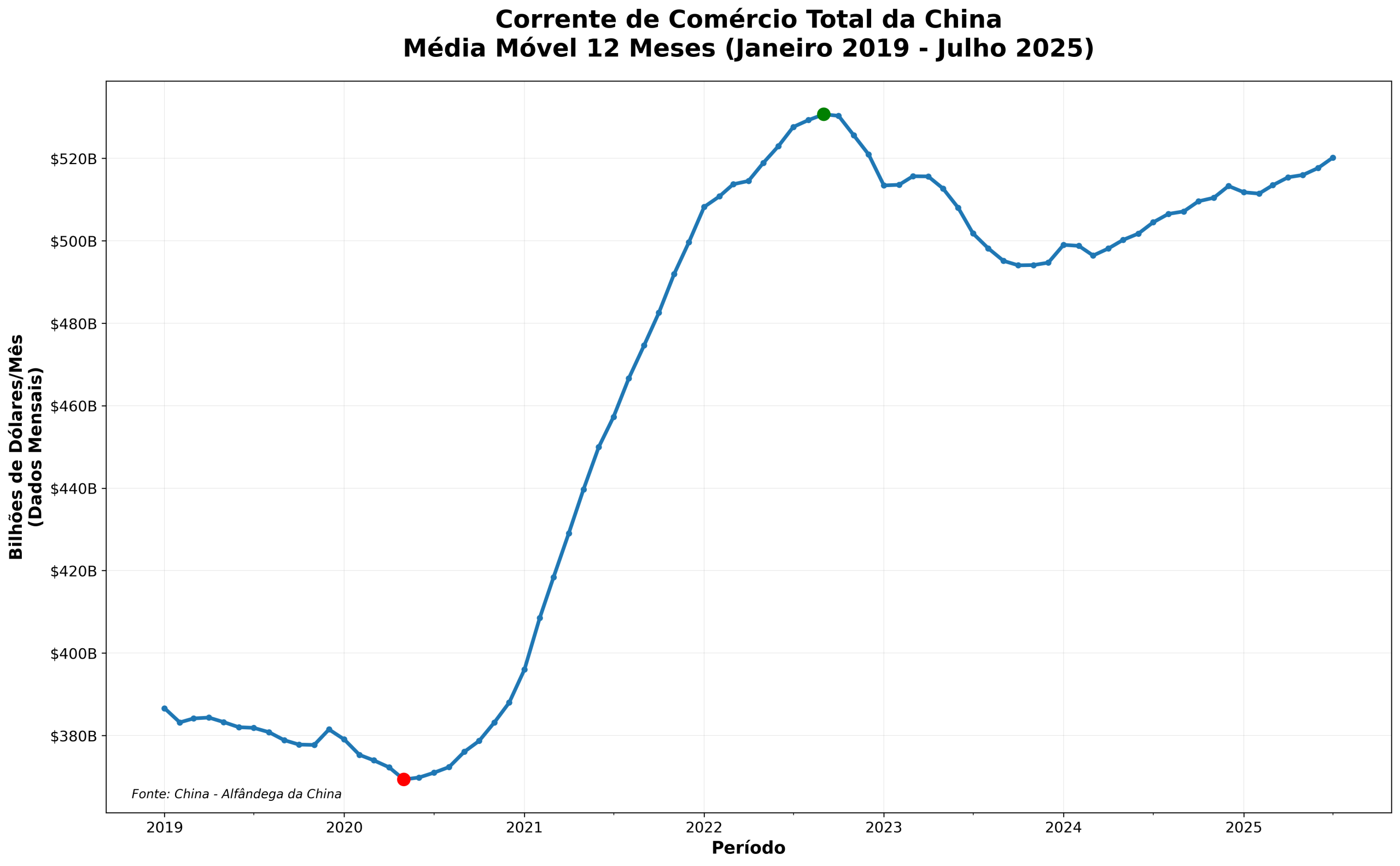
This net transfer of 9.4 percentage points—from the United States to BRICS—is of historical significance. In absolute terms, BRICS now moves $81 billion more than the United States in trade with China, a difference equivalent to the GDP of countries like Uruguay or Croatia.
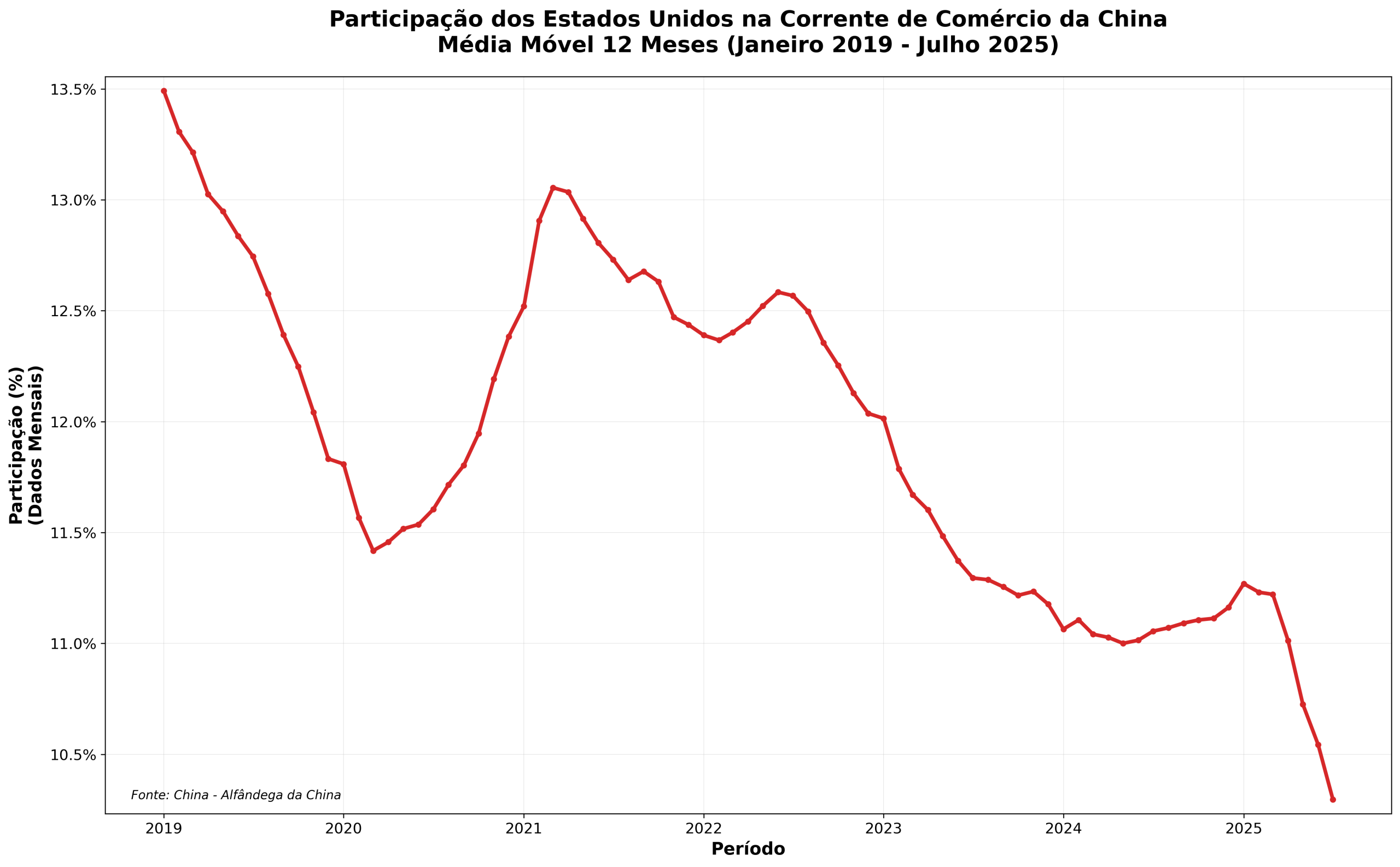
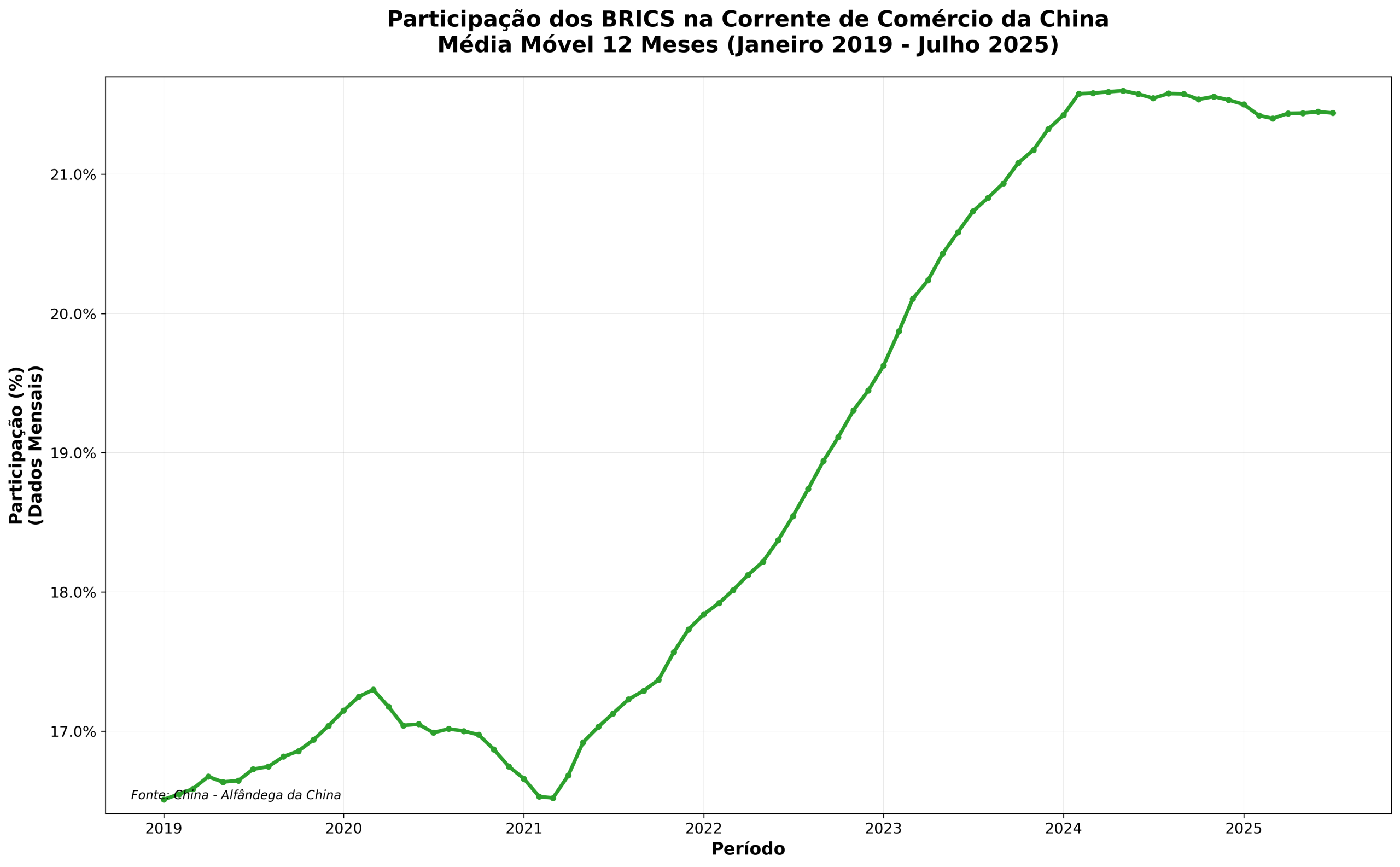
The New Melian Dialogue: When the “Weak” Have Nuclear Weapons
The fundamental difference between the original Bandung and the current realignment lies in the de facto power of the participants. When Washington tries to repeat a modern “Melian Dialogue” with ultimatums like “choose a side,” the response is no longer submission: it is Tianjin—a realignment that doesn’t ask for permission.
The protagonists of 2025 have learned their lesson. China, Russia, India, and others are not seeking “non-alignment”—an impossible neutrality—but an active realignment around a multipolarity they are building. When Indian Prime Minister Narendra Modi ignores four consecutive calls from American President Donald Trump and flies to meet Xi Jinping in Tianjin, he is not being neutral: he is choosing the side of strategic autonomy.
The meeting between Xi and Modi on August 31 was particularly symbolic. It was the first visit of an Indian leader to China in seven years, happening exactly at a time when Washington was applying 50% tariffs on Indian products and American officials were multiplying insults. Trump called India “brutal” and said the country has a “dead economy”; Treasury Secretary Scott Bessent accused India of “just profiting, reselling” Russian oil. Peter Navarro, a trade advisor, went further, saying India is a “money launderer for Russia” and declaring that “this is Modi’s war,” while accusing the country of “using our dollars to buy Russian oil.”
Modi’s response showed the White House’s self-inflicted wound: instead of giving in to ultimatums, India drew even closer to China. Xi Jinping received the prime minister with the phrase, “China and India are cooperative partners, not rivals,” proposing a “cooperative pas de deux of the dragon and the elephant.” The Indian reaction was to do the opposite of what Washington demanded: it chose the path of sovereignty. While the United States offers ultimatums and insults, Beijing offers partnership and mutual respect.
The data confirms that economic pragmatism is already showing up in the numbers. Even with historical border tensions, India’s share of Chinese foreign trade rose from 2.1% to 2.4% between January 2019 and July 2025—a 14% increase in relative terms over the six-and-a-half-year period. The monthly series, smoothed by a 12-month rolling average, indicates a consistent trend of commercial rapprochement.
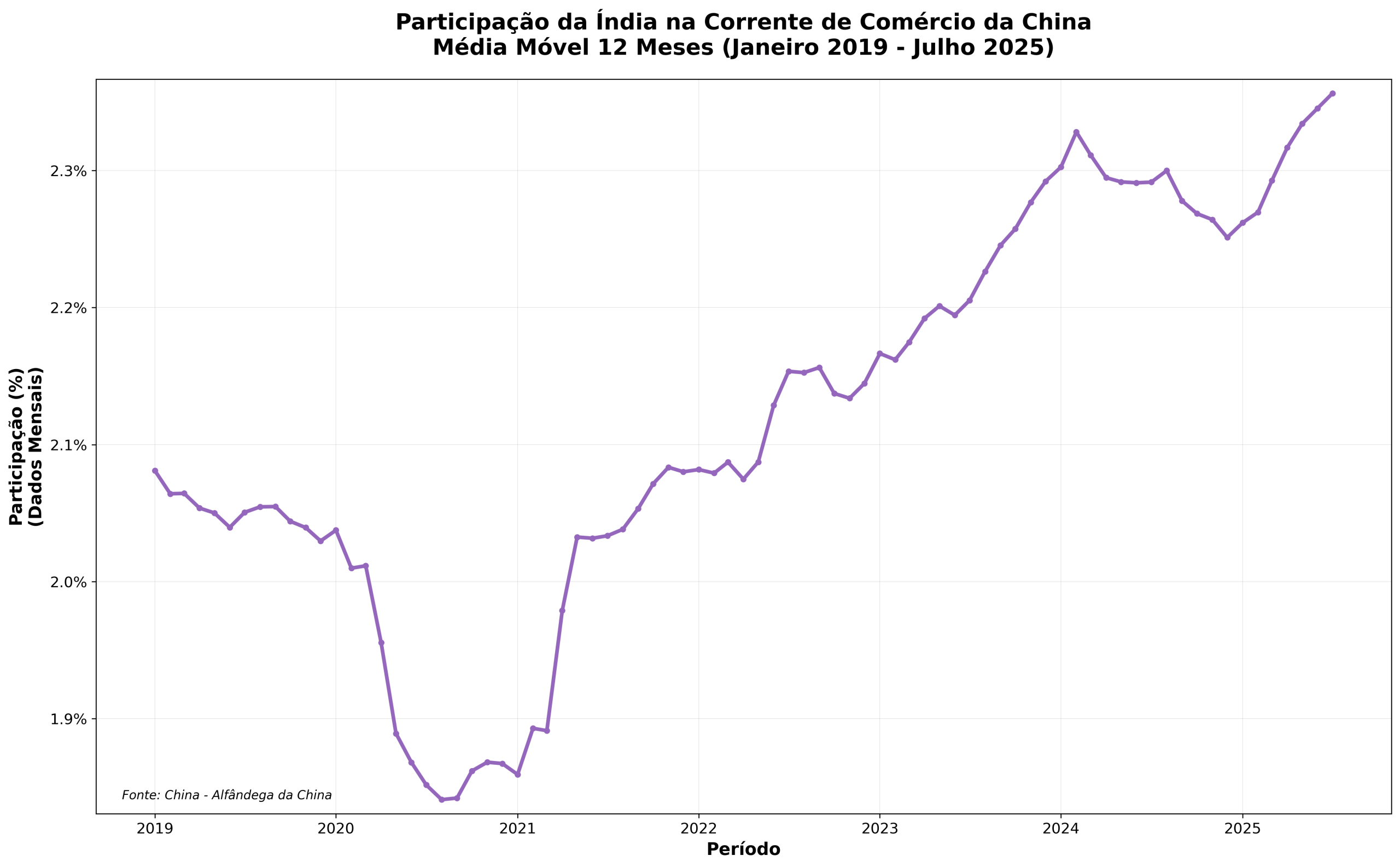
ASEAN: The Fastest-Rising Bloc
Perhaps the most impressive data point is the rise of ASEAN between 2019 and 2025. The Southeast Asian bloc, with 650 million inhabitants, jumped from a 12.7% to a 16.5% share of Chinese foreign trade—a 30% relative growth, surpassing even BRICS in dynamism. The monthly series, with a 12-month rolling average, shows the largest relative gain among all analyzed blocs.
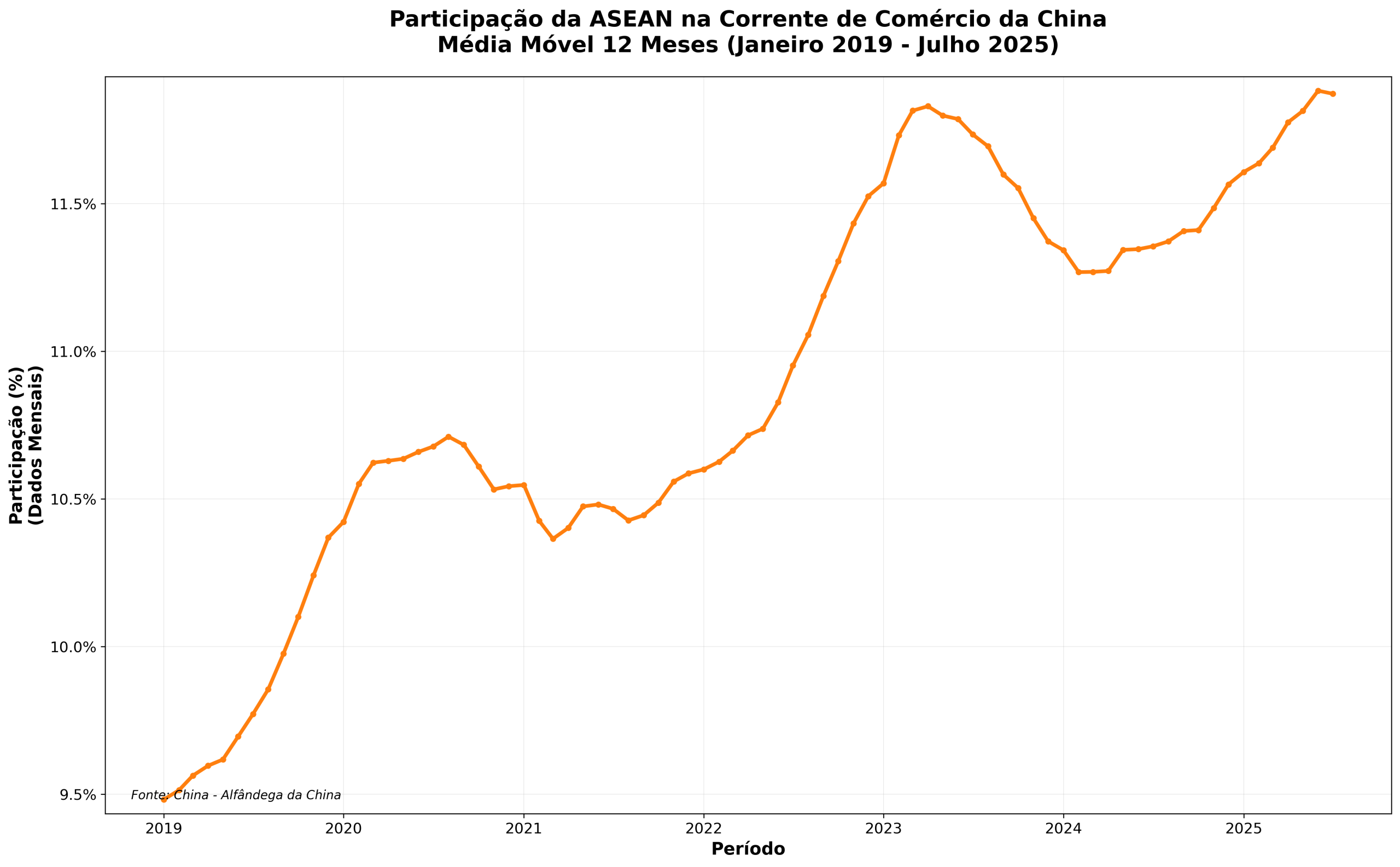
This growth matters because it indicates that the realignment is not just the work of great powers, but of entire regional blocs that are opting for an integration that bypasses the United States. Countries like Vietnam, Thailand, Malaysia, and Singapore—some of which are traditional allies of Washington—are prioritizing Asian economic integration over American dependence.
Brazil and South-South Cooperation
Brazil’s share of Chinese foreign trade rose from 2.5% to 2.9% between January 2019 and July 2025, a 16% rise in relative terms over the period, in parallel with the deepening of bilateral relations and the expansion of BRICS.
This rapprochement is accelerating precisely as Washington applies punitive tariffs to Brazilian products and revokes visas for national officials. A Genial/Quaest poll released in August 2025 confirms that the economic reorientation is already visible in public opinion: for the first time, Brazilians view China more favorably (49%) than the United States (44%).
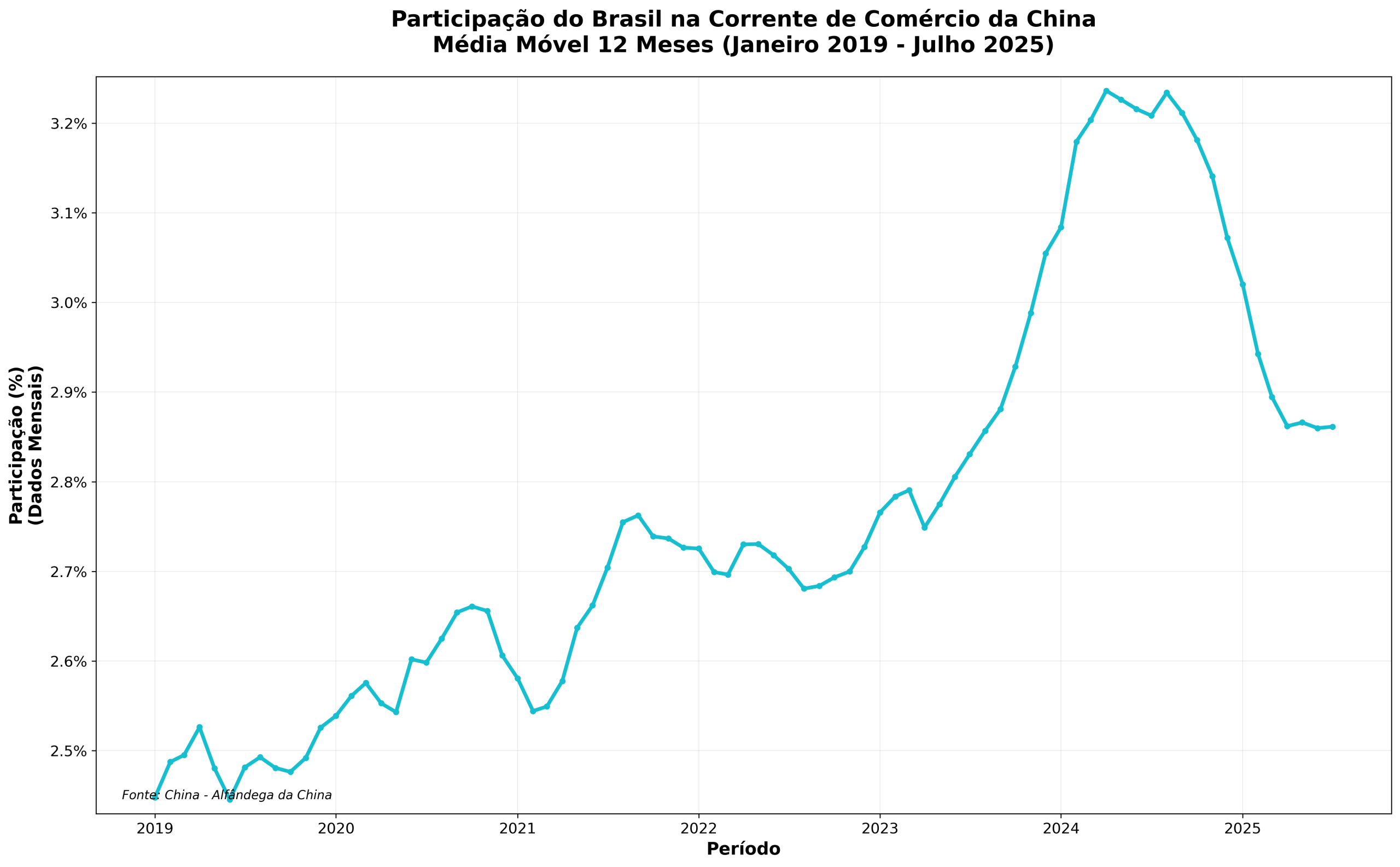
The Ultimate Irony: Trump Creates the World He Wanted to Destroy
The great irony is that Donald Trump, in trying to contain the rise of China and force countries to “choose a side,” has accelerated the very process he intended to stop. Punitive tariffs, diplomatic insults, and ultimatums have created an environment where China, Russia, India, Brazil, and dozens of other countries have concluded that, to preserve their sovereignty, they need to organize collectively.
When more than 20 countries, as a bloc, suspend sending packages to the United States after the end of tariff exemptions—a policy in effect since 1938—when France considers retaliating against American digital companies, when India adopts restrictive measures, and Brazil studies commercial responses, it’s clear: the isolation is not of others, it’s of the United States itself.
Tianjin 2025: The Historical Moment
The Tianjin meeting was not just another diplomatic summit. It was the moment when the multipolar world ceased to be an aspiration and became a concrete reality. When Vladimir Putin arrives in China with three deputy prime ministers and more than ten ministers for his sixth meeting with Xi Jinping in 2025; when António Guterres, the UN Secretary-General, participates in the SCO summit, legitimizing Asian multilateralism; when Modi and Xi speak of a “partnership of the dragon and the elephant”—this is not routine diplomacy.
We are witnessing the birth of a new world order.
The data obtained by O Cafezinho from Chinese Customs confirms the realignment: between January 2019 and July 2025, the American share of Chinese foreign trade fell by 24%, while BRICS grew by 31% and ASEAN by 30%. It is the precise measure of a geopolitical movement that is redefining the 21st century. All data is monthly and calculated by a 12-month rolling average to smooth seasonal variations.
The New Melians Have $40 Trillion
Unlike the original Bandung, which failed because its participants were economically weak and militarily vulnerable, the current movement—more a true realignment than “non-alignment”—has the power to sustain its choices: 3.5 billion people, $35–40 trillion in GDP, nuclear weapons, control of energy resources, and cutting-edge technologies.
When Washington today tries to re-enact the “the strong do what they can” dialogue, the response is no longer the submission of the weak. It is Tianjin: the demonstration that the new Melians have enough power to write their own rules. Unlike the original Melians, who were massacred by the Athenians, these new Melians have nuclear deterrence, about $40 trillion in GDP, and 45% of the world’s population.
The meeting on August 31, 2025, in Tianjin, was not just a diplomatic landmark. It was the moment when history turned the page: the day the world discovered that multipolarity had ceased to be a dream and had become an irresistible force.










